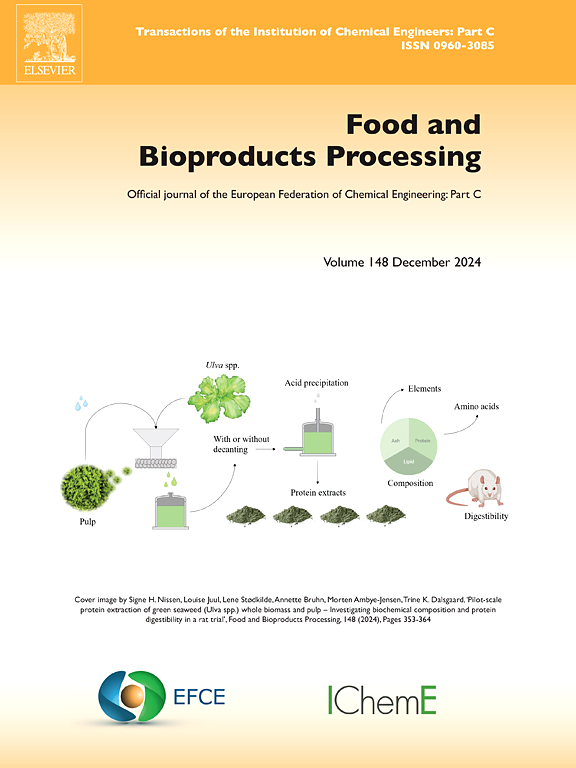脉冲电场(PEF)和低温浓缩(c)对马葵(Aristotelia chilensis (Mol.) Stuntz)和红叶小檗(Berberis microphylla G.)水提取物的理化性质、微生物质量和生物活性化合物的影响
IF 3.5
2区 农林科学
Q2 BIOTECHNOLOGY & APPLIED MICROBIOLOGY
引用次数: 0
摘要
本研究的目的是评估在马葵(Aristotelia chilensis (Mol.) Stuntz)和红叶小檗(Berberis microphylla G.)的水提取物中进行 PEF 处理和低温浓缩 (c) 对其理化性质、微生物质量和生物活性化合物的影响。通过水萃取水溶性化合物的方法获得马桑子和卡拉夫特的提取物,然后用 PEF(10 kV/cm,70 Hz,脉宽 10 µs)和巴氏杀菌法(90°C/30 秒)对样品进行处理;未处理的样品用作对照。处理后的提取物通过离心过滤进行低温浓缩,低温浓缩参数包括分离效率(EFF)和回收溶质(RS)。此外,还评估了理化性质,如可溶性固形物(SS)、可滴定酸度(TTA)和粘度(ƞ),以及生物活性化合物含量:总多酚(TP)、总花青素(TA)、总黄酮(TF)和抗氧化能力(AOXC)。微生物质量通过嗜中性需氧微生物(MAM)以及霉菌和酵母菌(M&Y)的计数进行评估。结果表明,溶质的有效成分在马葵中高于 95%,在卡拉法特中高于 97%。不出所料,低温浓缩过程增加了 TA、ƞ 和 SS 的含量。同时,TP、TF、TA 和 AOXC 含量也明显增加(p<0.05)。微生物学结果表明,PEF 处理以及低温浓缩和冷藏贮存可使马魁低温浓缩果的微生物质量保持 50 天以上,而 Calafate 低温浓缩果的微生物质量保持时间为 20 天。此外,两种低温浓缩物的理化参数和生物活性化合物在冷藏储存期间保持稳定。这些结果表明,将 PEF 与低温浓缩结合使用,似乎是对高 AOXC 果汁进行微生物和理化稳定化处理以及增加生物活性化合物含量的一个不错的选择。本文章由计算机程序翻译,如有差异,请以英文原文为准。
Effect of Pulsed Electric Field (PEF) and cryoconcentration (c) in aqueous extracts of maqui (Aristotelia chilensis (Mol.) Stuntz) and calafate (Berberis microphylla G.) on physicochemical properties, microbiological quality, and bioactive compounds
The objective of this study was to evaluate the effect of PEF treatment followed by cryoconcentration (c) in aqueous extracts of maqui (Aristotelia chilensis (Mol.) Stuntz) and calafate (Berberis microphylla G.) on their physicochemical properties, microbiological quality, and bioactive compounds. Extracts of maqui and calafate were obtained by aqueous extraction of water-soluble compounds, and then samples were treated by PEF (10 kV/cm, 70 Hz and a pulse width of 10 µs) and pasteurization (90°C/30 s); untreated samples were used as controls. The treated extracts were cryoconcentrated using centrifugation-filtration, and the cryoconcentration parameters included separation efficiency (EFF) and recovered solute (RS). Physicochemical properties were also evaluated, such as soluble solids (SS), titratable acidity (TTA), and viscosity (ƞ), as well as bioactive compound content: total polyphenols (TP), total anthocyanins (TA), total flavonoids (TF) and antioxidant capacity (AOXC). Microbiological quality was evaluated by the counts of the mesophilic aerobic microorganism (MAM) and molds and yeasts (M&Y). The results showed that the EFF of the solutes was higher than 95 % in maqui and 97 % in calafate. As expected, the cryoconcentration process increased TA, ƞ, and SS content. It also significantly increased (p<0.05) in TP, TF, TA, and AOXC content. The microbiological results showed that PEF treatment, together with cryoconcentration and refrigerated storage, maintained the microbiological quality of maqui cryoconcentrates for more than 50 days, whereas in calafate cryoconcentrates, it was maintained for ∼20 days. Moreover, the physicochemical parameters and bioactive compounds of both cryoconcentrates remained stable during the refrigerated storage period. These results demonstrate that the combined use of PEF with cryconcentration seems to be a good option for microbiological and physiochemical stabilization of fruit juices with a high AOXC and for increasing the content of bioactive compounds.
求助全文
通过发布文献求助,成功后即可免费获取论文全文。
去求助
来源期刊

Food and Bioproducts Processing
工程技术-工程:化工
CiteScore
9.70
自引率
4.30%
发文量
115
审稿时长
24 days
期刊介绍:
Official Journal of the European Federation of Chemical Engineering:
Part C
FBP aims to be the principal international journal for publication of high quality, original papers in the branches of engineering and science dedicated to the safe processing of biological products. It is the only journal to exploit the synergy between biotechnology, bioprocessing and food engineering.
Papers showing how research results can be used in engineering design, and accounts of experimental or theoretical research work bringing new perspectives to established principles, highlighting unsolved problems or indicating directions for future research, are particularly welcome. Contributions that deal with new developments in equipment or processes and that can be given quantitative expression are encouraged. The journal is especially interested in papers that extend the boundaries of food and bioproducts processing.
The journal has a strong emphasis on the interface between engineering and food or bioproducts. Papers that are not likely to be published are those:
• Primarily concerned with food formulation
• That use experimental design techniques to obtain response surfaces but gain little insight from them
• That are empirical and ignore established mechanistic models, e.g., empirical drying curves
• That are primarily concerned about sensory evaluation and colour
• Concern the extraction, encapsulation and/or antioxidant activity of a specific biological material without providing insight that could be applied to a similar but different material,
• Containing only chemical analyses of biological materials.
 求助内容:
求助内容: 应助结果提醒方式:
应助结果提醒方式:


